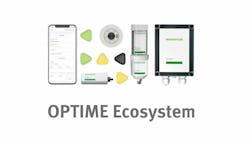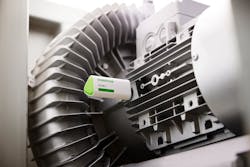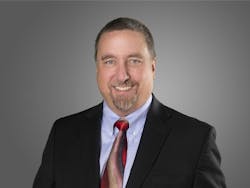Predictive Maintenance Systems Enable Better Machine Monitoring
Predictive maintenance systems provide the ability to monitor various components and systems within machines. The performance data they collect can be used to determine if and when a component or machine might fail, allowing users to be more proactive about addressing potential issues before they occur.
Integration of sensors and other components enable these systems to continuously monitor machine assets, eliminating the need for manual inspections. Users can remotely access the data and even get alerts when an issue is detected.
These capabilities are helping to ease the workload of maintenance professionals by providing them with better insights and analysis into the performance of their machines. It also prevents potential safety issues by removing the need to access assets physically unless necessary. And as the amount of skilled labor enters the maintenance field, the remote monitoring provided by predictive maintenance systems will become increasingly important.
Motion technology company Schaeffler developed its OPTIME Ecosystem to ease implementation and use of predictive maintenance. It includes various elements to allow remote monitoring and analysis of rotational equipment in industrial applications.
Power & Motion had the opportunity to speak with Dr. Felix Tenner, Lifetime Solutions Americas Vice President, and Frank Mignano, Condition Monitoring Sales Manager, Schaeffler, about the OPTIME Ecosystem and how predictive maintenance systems can benefit an operation.
*Editor’s Note: Questions and responses have been edited for clarity.
Power & Motion (P&M): Can you provide an overview of the Schaeffler OPTIME Ecosystem – what technologies are involved and the role it plays in enabling predictive maintenance?
Dr. Felix Tenner (FT): The OPTIME ecosystem actually consists of three different devices – it’s the OPTIME sensor for vibration and temperature measurement, the automated lubricator and the gateway. All of those are connected to and through each other, they all talk to and through each other. It is a completely wireless technology. It's a mesh network, all of [the devices are] connected. All the data is collected in the cloud, and we can analyze the data and give notifications to the customer.
Frank Mignano (FM): It's a wireless ecosystem that currently consists of vibration and lubrication status. We're going to be adding to that. But it's a great starting point. Very easy to deploy and it has been helping out a lot of our customers to improve their reliability.
FT: To touch on one more part, because it is something we get asked on a regular basis, especially in the last couple of months, is if we use AI (artificial intelligence) in our system and yes, we do. But we also have actual intelligence in our system, not only artificial intelligence, from our 30 years of condition monitoring experience and especially our 120 years of experience as a bearing manufacturer and bearing designer.
We not only calculate values in the cloud, but we can really prove those calculations and back them up with all the knowledge we gained [over] the last 120 years of manufacturing bearings.
P&M: Could you go into more detail about the OPTIME Condition Monitoring and Smart Lubrication technologies which are part of the overall ecosystem – how they work and what capabilities they bring to the market?
FM: I think one of the reasons we're seeing an explosion of these types of technologies is a couple of reasons. Certainly, the need has always been there, it's been there for 50 years. But the MEMS (Micro Electro Mechanical Systems) sensors that are available now, these are the types of sensors that are in your phone that can tell when you’re in portrait or landscape, but there are more advanced versions, they've gotten a whole lot better and more accurate to where we can use them in vibration systems and get excellent results. Very comparable to traditional accelerometers at this point. And, of course, the battery technology has exploded as well.
Ten years ago, the technology wasn't there to do what we're doing today; [now] you see it everywhere. In fact, a little too much. But I think those are keys for the vibration piece in particular. The lubrication component is just a fantastic [addition]. We're talking about rotating equipment – motors, pumps, fans, compressors – we want to know the condition of them, and we want to ensure that they're getting the proper amount of lubrication. So, [the automated lubrication device is] a great addition to the platform. That has helped us help people manage the health of their rotating equipment. When something goes sideways, we have alerts and notifications that we get to the customer, and then they can plan their maintenance around the results of the system.
FT: It’s all about putting the minds of maintenance engineers and maintenance managers at ease and let them sleep better because they know they have monitoring, and continuous monitoring, of all their assets; not only the critical ones but all their assets. They have an increase in productivity because they use OPTIME which is a wireless, easy to install and easy to use ecosystem.
READ MORE - Sensors Improve Monitoring of Hydraulic Oil Conditions
P&M: What other benefits are provided by these components? Is it just for that predictive maintenance capability or are there other benefits as well?
FM: One of the other things we really don’t talk about enough is safety. Keeping people away from rotating equipment is always a good idea, and hard to reach places [where components are located] that are typically unsafe. Putting sensors on [them] eliminates the need to walk up to them with a portable system; we have all the information – it’s up in the cloud, it’s on your phone, we’ll be alerted right away when something changes. So, safety is a key aspect I think we need to talk a little bit more about.
FT: It is also about not only acting on issues which come up and are severe issues which force you to act instantaneously but it is also about looking at trends. We have customers who have done planned downtime, once a quarter or once a year, and they know asset XYZ is not running 100% perfectly well but they are going to understand and know if [that asset] can make it to the planned downtime or not.
FM: The confidence in knowing that the assets are okay, because we collect so much data; we’re going to get 180 trend points every month. We identify an issue but then you [the customer] can just manage that issue.
We had a customer do this. We found a bearing defect in March and they said they would fix it in August during their downtime. I thought maybe not, the bearing might change things so they prepared for a sudden change but they made it to the [planned downtime] because they had confidence [in the data]. They had six readings every day, saw nothing was changing so continued to operate.
READ MORE - Leveraging 5G for Monitoring, Maintenance and More
P&M: When looking to implement a predictive maintenance solution such as OPTIME, what are some of the key factors which need to be taken into account?
FT: The first thing is to think outside of the box because most of our customers either do no monitoring at all or they do route-based monitoring once a month, or they do it with service providers who come in once a month or every other month, send a report and that’s about it. With that, you have an expert in the plant who does that [monitoring] and that’s fine. But you only do it once a month. And you might not be able to measure all your assets, maybe only the most critical assets. So that’s what we always tell our customers, there are no limits due to the fact OPTIME is easy to install and easy to scale, you can put OPTIME on every single asset in your plant and have them monitored with 180 measurement points per month.
So, you really need to think outside of the box and not only monitor the big and expensive machines but also look at those standard fans and pumps which can also be very critical if they fail because they could lead to an overall shutdown of the plant. Coolant pumps, for example, we have them in our own plants and they are normally in the basement, no one sees them, they are hidden until they break then everybody knows about them. As they run constantly, OPTIME is perfect to monitor them.
Talking about safety and convenience, climbing a cooling tower with 10 flights of stairs in the summer in Texas is not a pleasant experience. You might tend to not go there every other day or every other month even. For those kinds of [situations], OPTIME is a very nice solution. Cooling towers are normally outside in the rain, snow, or sun…and normally have a couple of flights of stairs. When they break, the whole plant shuts down because the temperature is not regulated anymore.
Those kinds of things are very important and therefore we also always do joint walk downs with our lifetime solutions specialists and field service engineers to support our customers in the field and solve problems.
FM: I took that question to mean what would people be looking for in a vendor and I just think there’s a lot of options out there and you want to look for a company that’s stable and is going to be around for the long haul and will support you into the future. You’re looking for a system that’s going to be easy to deploy because there’s less people in these plants, there’s more work for each one of them, they don’t need complicated things that they need to constantly tweak. You need something you can scan, put in and walk away; it just works for you.
You want a vendor that’s going to add to that portfolio, not just have vibration but have other things, other sensors, different types of technologies as you move forward. Complementary support options and a system that works, that’s got a reputation for working and providing value.
P&M: What challenges remain when it comes to implementing predictive maintenance solutions, and how can these be overcome?
FT: I think it's about establishing up to date predictive maintenance processes or adapt established processes. We touched on route-based versus wireless condition monitoring – it’s a big leap in technology, but it could be related to a mindset change as well. And Frank referred to a smaller workforce in the plants, it's just something we need to do sooner or later, and with our technology you can adapt to those changing working conditions and changing availability of workforce overall.
Having that mindset change is definitely a challenge. And some companies are more advanced than others when it comes to that. But we do training globally, we have our field service engineers in the field, we have OPTIME Solutions sales specialists which are really close to the customer. And with us, this training and support does not end after the installation of the system. That's where the work starts for us; after receiving the PO, the actual work starts for us because we want to make sure that the customer is ramping up properly and uses the system to its benefit, understands the data and analysis and all that. That's the most important part, having that mindset change for some customers and having training in place.
FM: I’ll touch on time and people, and we’ve talked about it already, there’s less people out there, there’s more on each of their plates, they have less time to dabble with things. So a system that goes in easy with a company that can support it, both the installation but also maybe remotely to analyze the machinery for them. Just [install the system] and tell me what I need to fix, we deal with customers like that. This is exactly where IoT (Internet of Things) comes in because we can help augment the retirement of folks or the lack of knowledgeable folks out there with technology and remote support services.
READ MORE - Proactive Maintenance: When IS the Right Time?
P&M: What, if any, technological advancements are yet needed to help further increase the uptake of predictive maintenance technologies or how do you see use of predictive maintenance in general progressing in the coming years?
FT: I think we are on a good path when it comes to technology. But that’s not what is currently limiting the use of these technologies in the field. It’s really about adapting processes to these new technologies, changing mindsets and being open to new technology overall. Having longer battery lifetime is good, having higher measurement frequency might be beneficial for some cases but 90-95% of the cases don’t need higher frequencies. It’s really about [getting] people to use the technology.
FM: The infrastructure, we use cellular networks and right now those are working great, I’m sure they will grow as systems like this grow in the industry. More and different types of sensors I think will be seen; you want to know if the back door or the garage door is open or closed, there’s going to be a sensor for that. Humidity sensors, specific temperature sensors to put on a particular part of your process because you know it has to be between X and Y temperature for the process to work properly. Just different types of technologies I think is what we’re going to see over the next 5 years or so.
About the Author
Sara Jensen
Executive Editor, Power & Motion
Sara Jensen is executive editor of Power & Motion, directing expanded coverage into the modern fluid power space, as well as mechatronic and smart technologies. She has over 15 years of publishing experience. Prior to Power & Motion she spent 11 years with a trade publication for engineers of heavy-duty equipment, the last 3 of which were as the editor and brand lead. Over the course of her time in the B2B industry, Sara has gained an extensive knowledge of various heavy-duty equipment industries — including construction, agriculture, mining and on-road trucks —along with the systems and market trends which impact them such as fluid power and electronic motion control technologies.
You can follow Sara and Power & Motion via the following social media handles:
X (formerly Twitter): @TechnlgyEditor and @PowerMotionTech
LinkedIn: @SaraJensen and @Power&Motion
Facebook: @PowerMotionTech

Leaders relevant to this article:






